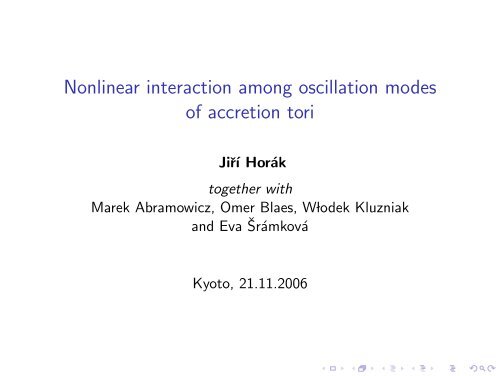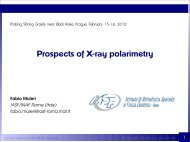Nonlinear interaction among oscillation modes of accretion tori
Nonlinear interaction among oscillation modes of accretion tori
Nonlinear interaction among oscillation modes of accretion tori
Create successful ePaper yourself
Turn your PDF publications into a flip-book with our unique Google optimized e-Paper software.
<strong>Nonlinear</strong> <strong>interaction</strong> <strong>among</strong> <strong>oscillation</strong> <strong>modes</strong><strong>of</strong> <strong>accretion</strong> <strong>tori</strong>Jiří Horáktogether withMarek Abramowicz, Omer Blaes, W̷lodek Kluzniakand Eva ŠrámkováKyoto, 21.11.2006
Outline◮ <strong>Nonlinear</strong> <strong>interaction</strong> <strong>of</strong> <strong>modes</strong>→ How to calculate nonlinear <strong>oscillation</strong>s <strong>of</strong> fluid bodies?◮ Slender <strong>tori</strong>→ Eigenfrequencies and eigenfunctions→ Coupling two <strong>modes</strong>, internal resonances◮ The 3:2 epicyclic resonance→ Resonance conditions→ Region <strong>of</strong> resonance◮ Excitation <strong>of</strong> the <strong>oscillation</strong>s by an instability→ Papaloizou-Pringle instability→ Three-mode interctions◮ <strong>Nonlinear</strong> diskoseismology (questions)...?◮ Conclusions, open quastions
<strong>Nonlinear</strong> <strong>interaction</strong>s <strong>of</strong> <strong>modes</strong>
Perturbative approach to nonlinearitiesGoverning equation (ξ = Lagrangian displacement):D 2 ξ iDt 2 − 1 ρ ∇ [j (γ − 1)p(∇ · ξ)g ij + p∇ i ξ j] + ξ k ∇ k ∇ i Φ = ∑ na (n)i(ξ)◮ RHS → <strong>Nonlinear</strong> accelerations (perturbation)◮ Linear equation ⇒ eigen<strong>modes</strong> {ω A , ξ A } [Shutz(1980)],∂ 2 t ξ + ˆB∂ t ξ + Ĉξ = 0ˆB is anti-Hermitian, Ĉ is Hermitian → {ξ A } is still complete◮ Solution <strong>of</strong> nonlinear equationξ(x, t) = ∑ Ac A (t)ξ A (x)The equation governing nonlinear <strong>oscillation</strong>sdc Adt + iω Ac A =ib AF A (c I )... coupled oscillators
<strong>Nonlinear</strong> coupling functionsF A (c I ) = ∑ B,Cκ ABC c B c C + ∑B,C,Dκ ABCD c B c C c D + . . .◮ Second order → three-<strong>modes</strong> coupling [Dziembowski(1982)]κ ABC = 1 Z np(γ − 1) 2 η A η B η C + 3p(γ − 1)η [A η BC] + 2pη ABC −2 Vρ ξ i oA ξj B ξk C ∇ i ∇ j ∇ k Φ dV ,◮ Third order → four-<strong>modes</strong> coupling [Van Hoolst(1994)]κ ABCD = − 1 Z nγ(3 − 3γ + γ 2 )p η A η B η C η D + 8γp η [A η BCD] +3! V6γ(γ − 2)p η [A η B η CD] + ρ ξ i oA ξj B ξk C ξl D ∇ i ∇ j ∇ k ∇ l Φ dV◮ Fifth order → five-<strong>modes</strong> couplingκ ABCDE = 1 4!ZVnγ(1 + 6γ − 4γ 2 + 3γ 3 )p η A η B η C η D η E +10γ 2 (γ − 3)p η [A η B η C η DE] + 15γ(γ − 1)p η [A η BC η DE] + 20γ 2 p η [A η B η CDE] +20γp η [AB η CDE] − ρ ξ i oA ξk B ξl C ξm D ξn E ∇ i ∇ k ∇ l ∇ m∇ nΦ dV ,
Slender <strong>tori</strong>
Example system: slender torus◮ Polytropic equation <strong>of</strong> state:◮ Small filling parameter:ρ = ρ 0 f n (r, z), p = p 0 f n+1 (r, z)β 2 = 2(n + 1)p 0 /(ρ 0 r 2 0 Ω 2 0) ∼ (∆r/r 0 ) 2 ≪ 1◮ the function f is expanded in the maximal pressure point:[f = 1 − ¯ω r 2 − 2r ( ) ]0 dl¯x 2 − ¯ω z 2 ȳ02 ...ellipsesl 0 dr‘shrinking’ coordinates ¯x ≡ (r − r 0 )/βr 0 , ȳ ≡ z/βr 0z0.80.40−0.4−0.80 1 2 3 4 5 6r[2GM/c 2 ]0
Lowest-order <strong>modes</strong> (Blaes et al, 2006)Radial epicyclicVertical epicyclicX-mode +-mode Breathing mode
Eigenfrequencies...resonancesPolytropic index: n = 3/20, 25ω ×ω bFrequency [c 3 /GM]0, 20, 150, 1ω +0, 0503 4 5 6 7 8Radius [R S ]
Example <strong>of</strong> the internal resonance2:1 resonanceω bω += 2 10.060.05plus modebreathing modeAmplitudes0.040.030.020.0100 1000 2000¯t◮ Exchange <strong>of</strong> energy◮ Low-frequency modulationc+, cb0.060.030−0.03−0.060 50 100 150 200 250 300 350¯t
The 3:2 epicyclic resonance
Idea (Kluzniak & Abramowicz)◮ Torus oscillating radially δr(t) ∝ cos(ω r t)◮ Equation for vertical displacement:◮ Mathieu equation◮ Parametric resonanceδ¨z + ω 2 z [r 0 + δr(t)]δz = 0δ¨z + ω 2 z [1 + ɛ cos(ω z t)]δz = 0ω z= n , first possible: n = 3ω r 2
Resonance conditionsOrder General system Epicyclic <strong>modes</strong>resonance resonance condition2nd 1:2 1:2 m r = 2m v2:13rd 1:31:1 1:1 m r = m v3:14th 1:4 1:4 m r = 4m v2:33:2 3:2 3m r = 2m v4:1
Resonance region0.6r3:2... step in γ: 0.25 × 10 −2 Ω 0◮ Turbulence...?◮ Initial conditionstable0.4◮ Solution:unstable0.030.20.020.01 STA09.199 9.2 9.20109.1 9.3 9.5r 0 [GM/c 2 ]Ar [GM/c 2 ]→ torus at r 0→ A r = radial amplitude◮ no feedback vert → radA v ∝ e γt◮ Comparison to t th , t visc :(Arr 0) 2 10 −6 α t β 2
Resonance + turbulenceStochastic excitationdc Adt + iω Ac A =→ Q A (t) is a stochastic functionib A[F A (c I ) + Q A (t)]Inspiration:Nayfeh & Serhan (1989):→ 1:2 internal resonance→ coupled <strong>oscillation</strong> excited
Three-mode resonancesandnonlinear Papaloizou-pringle instability
Papaloizou-Pringle instability in slender <strong>tori</strong>◮ Constant angular momentum distribution◮ Expansion in the torus thickness [Blaes & Šrámková]:β ≡ ∆rRω = ω (0) + βω (1) + . . . ,W = δpρσ = W (0) + βW (1) + . . . .Corotation mode: Marginal stabilityω 0W 0= Ω 0 + i √ 2 mβ bj »= C 0 1 + m 2 β 2 a 2¯x 2 − b 2 ȳ 2 + 4√ – ff2 ib¯x + ¯ω2 r b 2 − ¯ω z 2 a 2+ O(β 3 )¯ω r2 2(n + 1)¯ω r 2 ¯ω z2wherea 2 ≡ 4(1 + 2n) + ¯ω2 r4(1 + n)¯ω 2 r, b 2 ≡ 4 − ¯ω2 r.4(1 + n)¯ω r2⇒ Principal mode <strong>of</strong> the Papaloizou-Pringle
Growth-rates <strong>of</strong> the unstable modeDependence on the polytropic index and torus thickness10 0CUSPn = 1n = 2n = 3Ω K10 0β = 0.05β = 0.1β = 0.2β = β cuspγ/Ω0γ/Ω010 −110 −110 0 10 1 10 2(r − r ms)/(GM/c 2 )10 0 10 1 10 2(r − r ms)/(GM/c 2 )
<strong>Nonlinear</strong> evolution: three-mode coupling◮ Saturation by resonant <strong>interaction</strong>s with damped <strong>modes</strong>◮ Stars [Dziembowski 82, Moskalik 85, Nowakowski 05,...]Common resonant triples (m = 1 corotation mode):δω ≡ ω 1 + ω 2 − ω 3 ≈ 0 = ω + (Ω 0 − ω) − Ω 0 + O(β 2 )m 1 + m 2 − m 3 = 0 = 0 + 1 − 1Amplitude equationsȦ 1 = γ 1A 1 + i ω 1κA ∗ 2 A 3e iδωtȦ 2 = γ 2A 2 + i ω 2κA ∗ 1 A 3e iδωtȦ 3 = γ 3A 3 + i ω 3κA 1A 2e −iδωt⇒ Unstable ‘parent’ mode (γ 3 > 0) → Damped ‘daughter’ <strong>modes</strong> (γ 1,2 < 0).
Three-mode dynamics◮ |γ 3| |γ 1| + |γ 2| ⇒ unstableamplitude10.5Parent modeDaughter 1Daughter 200 50 100 150 200time◮ |γ 3| ≪ |γ 1| + |γ 2| & δω > δω crit ⇒ saturationamplitude10.5Parent modeDaughter 1Daughter 200 50 100 150 200 250 300 350 400 450 500time◮ |γ 3| ≪ |γ 1| + |γ 2| & δω < δω crit ⇒ stable limit cycles0.3amplitude0.20.1Parent modeDaughter 1Daughter 200 50 100 150 200 250 300 350 400 450 500time
Observable consequence?Three mode coupling condition: ω 1 + ω 2 ≈ ω 3→ XTE 1550-564:92Hz + 184Hz = 276Hz→ GRS 1915+105: Fibonacci series (W.K.)16Hz + 41Hz ≈ 67Hz41Hz + 67Hz ≈ 113Hz. . .... ‘Grand-daughter’ <strong>modes</strong> (?)
<strong>Nonlinear</strong> diskoseismology
p-g-c coupling...?150r inpM = 10M ⊙ , a = 0.5100gν [Hz]50c05 10 15 20r/R g
Conclusions
Conclusions◮ Unstable <strong>modes</strong> may be saturated by resonant processes◮ Damped <strong>modes</strong> may reach substantial amplitudes◮ Limit cycles: Low-frequency modulation (time scale ∝ 1/γ 3 )Main question = damping◮ α-viscosity seems to be insuficient◮ MHD turbulence, disipation◮ <strong>accretion</strong>(reduces excitation rate and increases damping rates)Other quastions◮ Role <strong>of</strong> the additional internal resonances (e.g. 1 : 2 : 3)◮ Saturation <strong>of</strong> other global instabilities.→ MRI [linear analysis by Curry & Pudritz 95]



